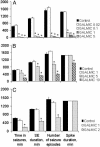Galmic, a nonpeptide galanin receptor agonist, affects behaviors in seizure, pain, and forced-swim tests
- PMID: 15240875
- PMCID: PMC478593
- DOI: 10.1073/pnas.0403802101
Galmic, a nonpeptide galanin receptor agonist, affects behaviors in seizure, pain, and forced-swim tests
Abstract
The pharmacological exploitation of the galanin receptors as drug targets for treatment of epilepsy, depression, and pain has been hampered by the lack of workable compounds for medicinal chemists from random screening of large chemical libraries. The present work uses the tripeptidomimetic galnon and displays its presumed pharmacophores on a rigid molecular scaffold. The scaffold is related to marine natural products and presents three functional groups near one another in space, in a manner reminiscent of a protein surface. An active compound, Galmic, was identified from a small synthetic library and tested in vitro and in vivo for its affinity and efficacy at galanin receptors. Galmic has micromolar affinity for GalR1 receptors (Ki = 34.2 microM) and virtually no affinity for GalR2 receptors. In vitro, Galmic, like galanin, suppresses long-term potentiation in the dentate gyrus; it blocks status epilepticus when injected intrahippocampally or administered i.p. Galmic applied i.p. shows antidepressant-like effects in the forced-swim test, and it is a potent inhibitor of flinching behavior in the inflammatory pain model induced by formalin injection. These data further implicate brain and spinal cord galanin receptors as drug targets and provide an example of a systemically active compound based on a scaffold that mimics protein surfaces.
Figures






References
-
- Vrontakis, M. E. (2002) Curr. Drug Targets CNS Neurol. Disord. 1, 531–541. - PubMed
-
- Mazarati, A., Langel, U. & Bartfai, T. (2001) Neuroscientist 7, 506–517. - PubMed
-
- Bartfai, T., Hökfelt, T. & Langel, U. (1993) Crit. Rev. Neurobiol. 7, 229–274. - PubMed
-
- Branchek, T. A., Smith, K. E., Gerald, C. & Walker, M. W. (2000) Trends Pharmacol. Sci. 21, 109–117. - PubMed
-
- Wang, S., He, C., Hashemi, T. & Bayne, M. (1997) J. Biol. Chem. 272, 31949–31952. - PubMed
Publication types
MeSH terms
Substances
Grants and funding
LinkOut - more resources
Full Text Sources
Medical
Molecular Biology Databases

